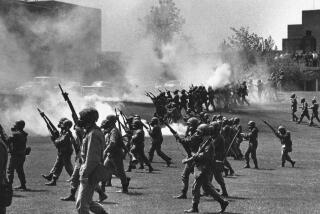Today’s Army Goes to Class at Civil War Battlefields
- Share via
BENTONVILLE, N.C. — BENTONVILLE, N.C. -- A Civil War battlefield park is giving modern-day troops lessons in war that their leaders say help give a new perspective to training and battles they face.
“You can use history to teach what went right and what you may need to change in your tactical situation,” said Fred Burgess, assistant manager of the Bentonville Battleground State Historic Site.
Today, the scene at the 280-acre park near Newton Grove is bucolic, with farmers’ cotton fields providing white highlights to the brown winter landscape.
But between March 19 and 21, 1865, some 4,100 Union and Confederate soldiers died in the pitched battle as the Civil War wound down. Gen. Robert E. Lee surrendered at Appomattox, Va., just 19 days later, on April 9.
Visitors to the battlefield come from Camp Lejeune Marine Corps Base and Ft. Bragg, headquarters of the 82nd Airborne Division and the Army’s Special Operations Command.
“I take them there because these Marines need to know what happened 137 years ago,” said Sgt. Maj. Clifton Sisson of the Marines Corps Engineer School at Lejeune.
He took a group of Marines to Bentonville in May, where they walked the battleground to get a feel for the scene of the action and, at the small visitors center, watched an illuminated map showing the battle’s progression.
“They need to know how commanders thought and what they did and why. They learn that commanders moved thousands of troops without radios and satellite communications.”
The commander of Camp Lejeune, Maj. Gen. David Mize, encourages all units at the base to visit battlefields because “U.S. Marines by definition are students of warfare,” said Col. Keith Oliver, the base spokesman.
Sisson said today’s troops learn that they don’t have it so bad in combat. As visitors walk the fields, they think not only about the tactics but the hard life -- how Civil War soldiers had to forage for food instead of ripping open a plastic-covered meal.
They can appreciate their advanced medical care when they visit Harper House, a Bentonville home turned into a Union field hospital.
There were no med-evac choppers or sterile surroundings, and not much in the way of painkillers. In the heat of battle, doctors and their assistants performed amputations as fast as they could, throwing discarded limbs out the windows of the homes where they worked. The wounded and dead lay outside, under trees.
That the battle of Bentonville even occurred was due to Lee’s determination to try to stop Gen. William Sherman, who was marching 60,000 troops toward a Union rail supply depot at Goldsboro. Lee dispatched Gen. Joseph Johnston from Raleigh with 20,000 men to try to block Sherman on the Goldsboro Road from Fayetteville.
Johnston’s outnumbered force held Sherman’s soldiers for the first day, employing the element of surprise, but by the third day Sherman’s army swept aside the Confederates and moved on.
Sherman had planned to resupply in Goldsboro and move north to join Gen. Ulysses S. Grant’s army and stop Lee. But Sherman wasn’t needed. Grant accepted Johnston’s surrender at Durham on April 26.
Tours of Bentonville aren’t formally organized but military groups are always expected at the park. Four or five groups have come during the year from Lejeune and Bragg. Inside the visitors center, several certificates of thanks from military units that have stopped in over the years hang above a door.
Military groups visit other battlefields as well. At Gettysburg National Military Park in Pennsylvania, at least one group tours the park’s 6,000 acres each month, said spokeswoman Katie Lawhon. The groups come largely from the Army War College in Carlisle, Pa., and the U.S. Military Academy at West Point, N.Y.
At the much smaller Bentonville, Burgess talks about other Civil War battles and discusses how changes in weaponry altered tactics from field standoffs to fights involving battlements and stealthy attacks.
“Slowly, they realize it is not unmanly to put something between you and the bullet,” Burgess said.
One of his favorite tactical comparisons is between the flanking maneuver used by Lee at Chancellorsville, Va., and the similar movement of U.S. troops during the 1991 Gulf War. U.S. forces marching toward Kuwait sent troops in a sweeping move on their left flank around Iraqi forces. At Chancellorsville, Lee used a similar move to send Gen. Thomas “Stonewall” Jackson and his soldiers to help defeat Union troops in Gen. Joseph Hooker’s Army of the Potomac.
Master Sgt. Charlie Davis, of the 261st Area Support Medical Detachment at Ft. Bragg, was visiting Bentonville with 58 soldiers. It was his third trip.
“They talk about it all the time now, how the battlefield was set up,” Davis said. “It helps us in learning how we need to do business today in the military.”
Sgt. Jon Smith, of the 602nd Area Support Medical Company at Bragg, visited with Davis and said the trip helped him appreciate today’s Army.
“We can move a regiment and flank the enemy quickly, whereas in the Civil War it might take days to get a message delivered,” Smith said. “You can see and appreciate what those guys went through.”
More to Read
Sign up for The Wild
We’ll help you find the best places to hike, bike and run, as well as the perfect silent spots for meditation and yoga.
You may occasionally receive promotional content from the Los Angeles Times.






